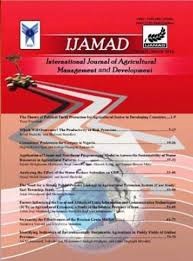بررسی ادراک به نژادگران نسبت به مزایا و معایب به کارگیری به نژادی مشارکتی در ایران
Subject Areas : Farming Systemsامیر نعیمی 1 , مصطفی کرباسیون 2 , فاطمه عباسی 3
1 - استادیار گروه ترویج، ارتباطات و توسعه روستایی دانشگاه زنجان
2 - دانشکده کشاورزی، دانشگاه شهرکرد، ایران
3 - دانشجوی دکترای ترویج و آموزش کشاورزی، دانشگاه بوعلی سینا، ایران
Keywords: ترویج کشاورزی, به نژادی مشارکتی, رهیافت مشارکتی, ادراک به نژادگران,
Abstract :
هدف این پژوهش بررسی مزایا و معایب بهکارگیری بهنژادی مشارکتی بود. 76 بهنژادگر از بین 95 بهنژادگر موسسه تحقیقات اصلاح بذر و نهال کرج، به عنوان نمونه مورد مطالعه به طور تصادفی انتخاب شدند. دادهها از طریق پرسشنامه به عنوان ابزار تحقیق گردآوری شده است. روایی ظاهری و محتویی پرسشنامه توسط پانلی از متخصصان ترویج و آموزش کشاورزی بازبینی و تایید شد. پایایی پرسشنامه بین 83/0 تا 92/0 بدست آمد. یافتههای توصیفی پژوهش نشان دادند که بهنژادگران ادراک مثبتی درخصوص بهکارگیری بهنژادی مشارکتی داشتند. نتایج آزمون همبستگی نشان میدهد که همبستگی مثبت و معنیداری در سطح خطای یک درصد بین سطح آشنایی با بهنژادی مشارکتی، مزایا و ادراک بهنژادگران نسبت به بهکارگیری بهنژادی مشارکتی وجود داشت. همچنین همبستگی منفی و معنیداری در سطح خطای یک درصد بین معایب بهنژادی مشارکتی و ادراک بهنژادگران درخصوص بکارگیری آن وجود داشت. نتایج حاصل از تجزیه و تحلیل رگرسیون به روش گام به گام نشان داد که دو متغیر مزایا و معایب بهکارگیری بهنژادی مشارکتی، در مجموع 58 درصد از تغییرات ادراک بهنژادگران درخصوص بهکارگیری بهنژادی مشارکتی را تبیین میکنند.
Aref, F. (2010). Barriers of agricultural development in Iran: A case study of Fars Province. Journal of American Science, 6 (11), 155-158.
Bhargav, D.K., & Meena, H. P. (2014). Participatory Plant Breeding: Farmers as Breeders. Popular Kheti, 2(1), 7-14.
Ceccarelli, S. (2008). Importance of participation in research regional and international breeding programs. The first national breeding grain workshop, Kermanshah, 13-14 October, Iran.
Ceccarelli, S. (2009). Evolution, plant breeding and biodiversity. Journal of Agriculture and Environment for International Development. 103, 131-145.
Ceccarelli, S. (2012). Plant breeding with farmers. A Technical manual. International Center for Agricultural Research in the Dry Areas (ICARDA), Aleppo, Syria, Pp. 6-12.
Ceccarelli, S., & Grando, S. (2008). Decentralized plant breeding with participatory method. Arman Ardalan (translator). Tehran: Institute of Sustainable Development of Environment, P.128
Ceccarelli, S., Grando, S., & Baum, M. (2007). Participatory plant breeding in water-limited environments. Experimental Agriculture, 43, 411-435.
Ceccarelli, S., Grando, S., Tutwiler, R., Baha, J., Martini, A. M., Salahieh, H., Goodchild, A., & Michael, M. (2000). A methodological study on participatory barley breeding I. Selection Phase. Euphytica, 111, 91-104.
Davis, J. A. (1971). Elementary survey analysis. Englewood, Prentice Hall. NJ.
Fami, SH. H. (2006). Principles of agricultural extension and education. Tehran: Payam Noor University Press. P. 373
David, R. (1999). Participatory Action Research and social change. New York: Ithaca, Cornell University. p. 273
Gangn, C. N., Cheng, SH., Huang, L., & Sambou A. (2010). Sustainable agriculture in Benin: Strategies for applying the Chinese circular agriculture model. Journal of Sustainable Development, 3(1), 25-32.
Heidari, H., Impiglia, A., Darayi, L., & Mirzaei, F. (2007). Farmer field school deliver results in Iran. Integrated Pest Management, Pesticides News, 76, 43-54.
Lahmar, R. (2010). Adoption of conservation agriculture in Europe: Lessons of The KASSA Project. Land Use Policy, 27, 4–10.
Mayer, R. (2013). Technology options for feeding 10 billion people Plant breeding and innovative agriculture. Institute for Technology Assessment and Systems Analysis (ITAS). Retrieved from http://www.europal.europa.eu/stoa/cms/studies.
Maghirang, R. G., Rodulfo, G. S., Madrid, I., Ferry, E., Cruz, C., Vilbar, L., & Misterio, J. S. (2014). Participatory Breeding on Organic Vegetables. Proceedings of the 4th ISOFAR Scientific Conference. ‘Building Organic Bridges’, at the Organic World Congress, 13-15 Oct., Istanbul, Turkey. P. 912.
Miller, L.E., & Smith K.L. (1983). Handling non response issues. Retrieved from the www.joe.org/joe/1996 February/ rb2.html
Moemeni, M., & Ghayomi, A. (2007). Statistical analysis with using SPSS. Tehran: Ketab-e-No.
Morris, M. L., & Bellon, M. R. (2004). Participatory plant breeding research: opportunities and challenges for the international crop improvement system. Euphytica, 136, 21–35.
Murphy, K., Lammer, D., Lyon, S., Carter, B., & Jones, S.S. (2005). Breeding for organic and low-input farming systems: An evolutionary-participatory breeding method for inbred cereal grains. Renewable Agriculture and Food Systems Journal Renew, 20, 45-55.
Mustafa, Y., Ceccarelli, S., & Grando, S. (2005). Benefit-cost analysis of participatory breeding program in Syria. International Center for Agricultural Research in the Dry Areas (ICARDA).P.O. Box 5466, Aleppo, Syria.
Rolling, N., & Pretty, J. N. (1997). Extension role in sustainable agricultural development. In: Improving Agricultural Extension, A reference manual (Eds. Swanson et al.), FAO, Rome. p. 512.
Surangsri, W. C., & Nunta, B. (2005). Factors Affecting the adoption and non-adoption of sloping land conservation farming practices by small-scale farmers in Thailand. In Kheoruenromne, I.; Riddell, J. A.; Soitong, K. (Eds.). Proceedings of SSWM 2004 International Conference on Innovative Practices for Sustainable Sloping Lands and Watershed Management, 5-9 September 2004. Bangkok, Thailand: Department of Agricultural Extension. Pp.257-267.
Yiching, S., & Jingsong, L. (2011). The role of biodiversity, traditional knowledge and participatory plant breeding in climate change adaptation in Karst mountain areas in SW China. A country case study on the impacts of climate change and local people’s adaptation. International Institute for Environment and Development, Retrieved from the: http://www.eldis.org/go/home&id=60588&type=Document#.WNdUsGfVDDc


